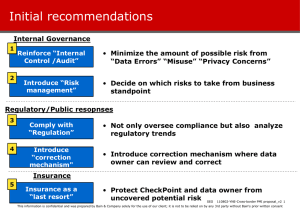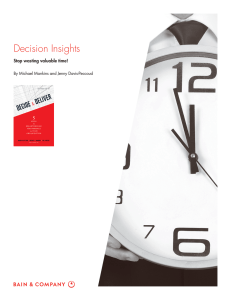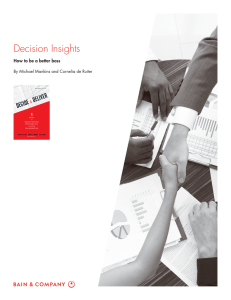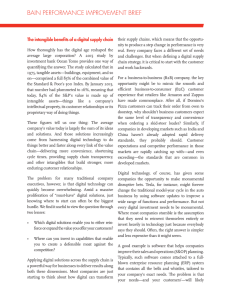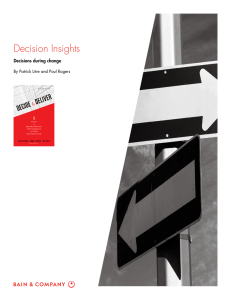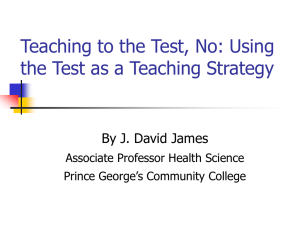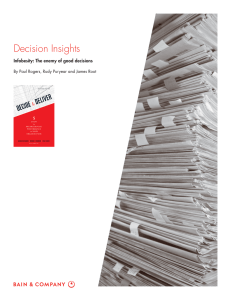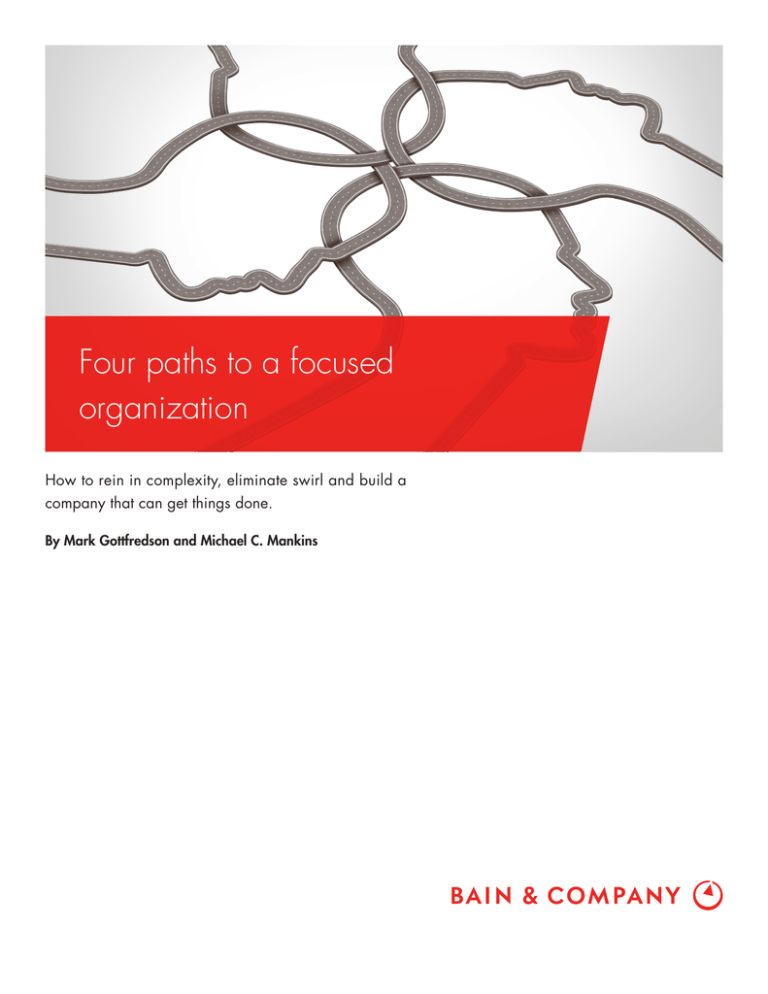
Four paths to a focused
organization
How to rein in complexity, eliminate swirl and build a
company that can get things done.
By Mark Gottfredson and Michael C. Mankins
Four paths to a focused organization
Mark Gottfredson is a partner with Bain & Company in Dallas and a senior
member of the Global Performance Improvement practice. Michael C. Mankins
leads Bain & Company’s Organization practice in the Americas and is a
partner in San Francisco.
Copyright © 2013 Bain & Company, Inc. All rights reserved.
Four paths to a focused organization
At a large natural-resources company, hiring a new
general manager for a mine required the involvement
of three human resources professionals, four regional
leaders and two executives from corporate. Getting all
these people to agree on a new hire typically took
months. In the meantime, positions sat open and
promising candidates were snapped up by fastermoving competitors.
tional complexity, one of the most toxic ailments a
company can experience. Unchecked complexity in an
organization demoralizes employees, slows innovation
and raises costs. We have found that people in many
companies spend 25% or more of their time on lowvalue or inefficient activities. If you could get rid of all
that unproductive work, you could gain the equivalent
of 10 hours more a week from every employee.
At a global energy company, senior executives relied
on their own functions to gather data to support key
decisions. The requests led to countless hours of
uncoordinated work throughout the organization,
hundreds of different reports and many more hours
reconciling the reports’ conflicting or inconsistent
information. By the time executives got the data, it
was often out of date. When they requested an update,
the process started all over again.
Where does all the complexity come from? Growth.
Companies add product lines and business units.
They expand into new regions. They merge and acquire.
Every such move increases complexity and makes it
harder for people to work together effectively. To measure
how far complexity has progressed in your own organization, it’s helpful to examine four variables:
•
Nearly every large company has troubling stories like
these—bureaucracies running wild, decisions getting
stuck in the swamp, G&A costs spiraling out of control. They’re all manifestations of creeping organiza-
Nodes. A “node” is every point where elements of
an organization—functions, business units, regions
and so on—must interact to get something done.
If you track the number of nodes in your organization over several years, you’re likely to find that it
expands geometrically, because every new element
Figure 1: Complex organizations are often paralyzed by bureaucratic “swirl” and lose focus on what matters
Implications of “swirl”
1
2
Issue requires
resolution
5
Additional
requests come
from meetings
New process/
initiative
development
6
Data needed to
answer requests
7
Follow-up
meetings to
review answers
Resources and time required
to resolve issues increase
over time as meetings result
in additional meetings and
more work
High risk of additional problems
and “analysis paralysis”
Counter to cost reduction
priorities
3
4
Data needed to
track progress
Meetings scheduled
to update on
progress
Source: Bain & Company
1
Four paths to a focused organization
adds a new set of nodes. The energy company
mentioned earlier saw nodes increase from 800
to 12,000 over a 10-year period.
•
•
•
world. The same energy company we have been discussing created many general managers in hopes of
encouraging executives to think like owners. Each of
the new GMs expected to have his own HR staff, IT
department, finance department, quality department
and so on. But much of the work generated by these
units was unnecessary. A company needs financial
accounting, for example, at the business-unit level,
supported by good controls at corporate. It needs
benefits management at the country level (because
of country-specific regulations) and at corporate (for
maximum consistency). Everything else is likely to
be redundant.
Hierarchy. As organizations grow, they tend to
create new executive and staff positions, generating
more work for everybody. An analysis of management layers and managerial spans over time usually reveals ever-increasing hierarchy. Hierarchy
increases costs. An Australian bank found that
the fully loaded cost of every general manager
was about A$2 million. Each GM’s “caravan”—
the assistants and other subordinates, along with
all the work those people created—added at least
another million in cost.
Determining where the work needs to be done can
eliminate massive amounts of swirl. It also enables an
organization to simplify its structure, greatly reducing
the number of nodes. Restructuring the energy company cut the number of nodes from 12,000 to about
5,000, which facilitated faster decision making and
operations.
Unclear decision roles. Does every individual
know what role he or she plays in major decisions?
Internal surveys reveal that even relatively flat
organizations struggle to make critical choices
when decision roles are poorly defined. Bain
research shows that low decision effectiveness
correlates strongly with poor financial performance.
2. Determine the appropriate level of supervision for
each kind of work
“Swirl.” Ask people whether your organization
makes decisions faster than competitors, or faster
than it did in the past. Also look at your G&A
costs relative to competitors. Many companies
find that initiatives pile up, meetings proliferate
and everyone keeps asking for more and more
information. A “culture of swirl” develops, in
which every new issue generates additional work
and cost without producing results (see Figure 1).
“Delayering” is a time-honored fix for sclerotic organizations: A company broadens managerial spans
and eliminates layers of hierarchy. But delayering can
backfire unless it is done carefully. Highly repetitive,
transactional work can typically support a broad span
of control. Specialized work requires closer supervision
and thus a narrower span. The task is not simply to
delayer but to tailor the supervisory structure to the job.
Gauging where you stand on all these variables is the
first step toward a solution. Once you know how bad
the problem is, you can attack it on all four fronts.
Here’s how:
Ingersoll Rand, a $14 billion diversified manufacturer,
relied on just this approach when it attacked organizational complexity a short while ago. Initial studies
revealed that the company’s existing spans of control
ranged from 4 to 7, far below the industry benchmark average of 9. The company then identified
appropriate spans for various types of work—6 for
specialized product-management tasks, 11 for many
manufacturing jobs and so on. It created and then
implemented targets at this level of detail for all its
functions throughout the organization. The move
1. Decide where the work is to be done
We recently studied a large public university where
every department had its own HR, IT, finance and
administrative staff. You could write this off as a
typical example of academic bloat and inefficiency,
except that it isn’t so far removed from the corporate
2
Four paths to a focused organization
not only helped the company save some $26 million
in costs, it also led to faster decision making and a
more nimble organization.
wide range of industrial, automotive and communications applications. At one point the group was struggling with decisions about what should go on its
“roadmap” of products slated for development. The
general manager and marketing director responsible
for each of ECG’s three product areas wanted a say. So
did ECG’s strategic planning manager, who looked
across all three areas. Because of the confusion, said
then–general manager Doug Davis, “We were making
decisions without including the right people, so they
didn’t stick.” Quality and speed both suffered. “Someone who hadn’t been involved early on would bring
a new piece of data, and we’d go back and revisit
the decision.”
3. Assign roles for critical decisions
Every company has a set of key decisions that determine its business performance. The set includes not
just obvious high-value decisions such as major
investments but routine, everyday decisions that add
up to a lot of value over time. These decisions have to
be made and executed well and quickly, with a degree
of effort appropriate to the issue at hand. A good
decision-rights tool clarifies who plays the essential
roles in such a decision. Our own tool, called RAPID®,
assigns responsibility for Recommending, offering
Input, Agreeing, Deciding and Performing.
As part of a reorganization of his unit, Davis and his
team used RAPID to define roles for this and other
critical decisions. For the roadmap, they gave decision
authority to the strategic-planning manager within
ECG, as he was best placed to make trade-offs across
the division’s product areas. Implementation wasn’t
perfectly smooth. Some product general managers,
Smart use of RAPID makes for better, faster, more
effective decision making, as Intel’s Embedded and
Communications Group (ECG) discovered. ECG
develops and markets semiconductor devices for a
Complexity and orphan costs
In a simple world, every business would know its costs and manage them appropriately. When
organizational complexity intervenes, however, a business may have no ability to calculate or
manage its true costs. The results are predictable: costs spiral out of control.
IT costs are often a case in point. Corporate organizations create centralized ERP systems and
“backbones,” and then allocate the costs to business units. BUs don’t control the allocation and are
therefore not measured on controlling those allocated costs. So IT becomes essentially a free
resource. That creates a “tragedy of the commons” situation: Individual businesses ask for lots of IT
services because the cost is spread among many business units, and those charged with providing
the services have no reference base from which to judge what is of high value and what of lower
value. As a result, no one really controls the costs, and they tend to skyrocket.
Solving this problem requires basing the decisions more on market indicators. In this example, BUs
should be held accountable for IT costs, and for special requests in particular. To put some discipline into its own allocation of costs, the energy company mentioned in the main article formed a
board for the IT department made up of the department’s customers (business unit presidents). The
board set budgets and ensured that core costs were competitive with those of outside suppliers.
Soon after the company made this change, IT costs plummeted.
3
Four paths to a focused organization
for example, weren’t happy with “just” an input role
and would second-guess the strategic-planning manager’s decisions. But Davis and his team reinforced
the new roles, and soon the decisions were going
smoothly—and a lot more quickly. “We’re not thrashing around on these things as much,” said Davis.
“We’re not going back to revisit decisions that were
already made.”
posing an initiative to write a detailed business case in
support. Graham Packaging, a global manufacturer of
plastic containers, illustrates the power of incentives.
As part of a turnaround effort led by Mark Burgess,
the company developed a system known as the Earnings Improvement Plan (EIP). The EIP focused on
several specific initiatives designed to build shareholder
value, each one including detailed action plans and
accountabilities. It covered the vast majority of
employees, thus building engagement throughout the
organization, and it paid cash bonuses tied to achievement of EIP targets. The incentives helped everyone
at Graham Packaging stay focused on a set of simple,
measurable metrics under individuals’ control. It also
reinforced the importance of teamwork in solving
problems. Customer issues, for example, were no
longer “sales” or “operations” problems; they were
problems that had to be addressed cooperatively.
When Graham was sold to a strategic buyer in 2011,
its equity value was nine times what it had been when
the turnaround began.
4. Define and reinforce behaviors that eliminate the
culture of swirl
Many complexity issues persist or grow worse because
of the behavior of senior management. Suppose that a
company has established crystal-clear decision roles.
If executives routinely intervene in decisions or overrule the decision-maker’s choice, they undercut the
entire approach. It’s the same with other behaviors. If
executives routinely ask for more and more data, they
will generate more and more swirl. If they aren’t held
accountable for costs, they will tend to spend more
and more money (see the sidebar, “Complexity and
orphan costs”).
Organizational complexity is like an invasive weed,
sucking up resources and strangling the growth of a
healthy garden. But companies can use the variables
we outlined to assess how far complexity has progressed, and they can then attack it on all fronts. The
result will be a stronger, more productive organization—and better financial results.
Yet people don’t change their behavior easily, and
companies may need to create new processes and incentives to encourage them to do so. The mining
company we mentioned earlier found that it had 76
separate initiatives under way simultaneously. It eliminated all but 12, and it began requiring anyone pro-
RAPID® is a registered trademark of Bain & Company, Inc.
4
Shared Ambition, True Results
Bain & Company is the management consulting firm that the world’s business leaders come
to when they want results.
Bain advises clients on strategy, operations, technology, organization, private equity and mergers and acquisitions.
We develop practical, customized insights that clients act on and transfer skills that make change stick. Founded
in 1973, Bain has 50 offices in 32 countries, and our deep expertise and client roster cross every industry and
economic sector. Our clients have outperformed the stock market 4 to 1.
What sets us apart
We believe a consulting firm should be more than an adviser. So we put ourselves in our clients’ shoes, selling
outcomes, not projects. We align our incentives with our clients’ by linking our fees to their results and collaborate
to unlock the full potential of their business. Our Results Delivery® process builds our clients’ capabilities, and
our True North values mean we do the right thing for our clients, people and communities—always.
Key contacts in Bain’s Performance Improvement and Organization
practices:
Americas: Michael C. Mankins in San Francisco (michael.mankins@bain.com)
Jeff Denneen in Atlanta (jeff.denneen@bain.com)
Asia-Pacific:
James Root in Hong Kong (james.root@bain.com)
Europe,
Middle East
and Africa:
Jenny Davis-Peccoud in London (jenny.davis-peccoud@bain.com)
For more information, visit www.bain.com

